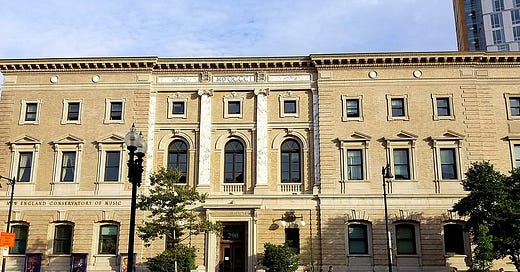Source
As a cultural critic, there are those unfortunate times when real life makes one’s points more vividly than one’s own writing ever could. One such instance occurred for me this morning, when an advertisement from New England Conservatory arrived in my inbox. The advertisement was for a day-long symposium on March 7 exploring the concept of “bimusicality,” a word coined in the 1960s by ethnomusicologist Mantle Hood but seldom used since, to describe musicians who can “perform and express themselves” in two different music cultures.
Why the term has been seldom used until recently should be clear to readers of my article “The Hospitable Playpen.” Up until the last few decades, intercultural exchange in music was regarded not only as an unalloyed good, but as a natural consequence of globalization. Musicians—whatever their ethnicity, gender, or creed—were free to take elements of their own music cultures and mix them with techniques learned elsewhere. The result, as we see in some of the 20th century’s greatest artworks, like Michael Tippett’s A Child of Our Time or Philip Glass’s Satyagraha, was a continuous affirmation of music as a universal language that learned a little bit from everyone so that it could speak to anyone.
That principle held strong until the 1990s, when the concept of “cultural appropriation”—long percolating through the academic fields infected by Edward Said’s methods of Postcolonial Theory—arrived at the music department. Cultural appropriation laid a series of landmines around the practice of cultural exchange, making it such a socially and professionally risky endeavor that most composers abandoned it altogether (except for those with personal ethnic claim to non-Western music cultures who chose to mix them with Western ones).
The simple reason why the term “bimusical” didn’t catch on in the 1960s, 70s, or 80s, is that it wasn’t necessary. Unlike being “bilingual” or “bisexual,” becoming conversant in multiple music cultures was not historically thought to entail the development of totally distinct practices, attitudes, or vocabularies. Rather, the skills we learned in different traditions were considered complementary, and their acquisition to be simply one of the things musicians did to become more widely educated. But today, now that playing in multiple music traditions has become a Harry Potter-esque soul-splitting exercise—or at least the artistic equivalent of dual citizenship—we suddenly need a word for it. And there, waiting for us, is “bimusical.”
The NEC conference—far from encouraging a return to the free exchange of musical ideas—seems to be devoted mainly to examining (and likely adding to) the miles of red tape in which that exchange is already wrapped. As the symposium summary informs us: “The age of YouTube did not diminish our obsession with the ‘other’ and cultural appropriation issues in any way. If anything, these issues are far more relevant now. So, how are 21st century musicians supposed to become culturally equipped to develop awareness toward these issues?”
Notice three things here: First, the vacuousness of the phrases “culturally equipped” and “awareness.” Second, that in the insular and suspicious lexicon of academia, people of other cultures has become the ‘other’—it is now impossible to have a genuine interest in other cultures without at least somewhat suspect motives. And third, the implication (subtly made with the phrase “cultural appropriation issues”) that the concept of appropriation itself is widely agreed upon and that the only room for debate on the subject is on the question of who’s guilty of it.
The paper abstracts submitted for the symposium by presenting ethnomusicologists Panayotis League (Florida State University), Ann Lucas (Boston College), and Marc Perlman (Brown University) do little to allay our concerns. Lucas’s talk is entitled “But Whose Music Is It?” League, whose abstract describes the concept of bimusicality as a “method-practice-lifeway,” summarizes his paper thusly:
As the field continues to expand and conversations are being driven by voices and perspectives that were notably absent in previous generations, we keep coming back to one of the fundamental issues posed by the practice of ethnography, albeit from different angles each time: how do we responsibly and productively navigate the tensions and power differentials inherent in scholarship that is necessarily subjective and even autobiographical, on the one hand, and fundamentally concerned on the other with the fictive representation of human beings and their social-artistic-emotional lives in a context explicitly framed as non-fiction?
And to think I just wanted to hear some decent music! Sounds like a pretty fraught lifeway to me.
The rest of the day is jam-packed with similarly scintillating conversations—a panel discussion, a presentation, and a Turkish buffet to top it off (!!). Come to think of it, if I had been a Bostonian, perhaps I would have attended just to grab a pide. Plus, you never know when you might meet a great practitioner of non-western musics who might be enticed to incorporate them into a new orchestral masterwork. After all, you know what they say. Bi now, Western Classical later.





Riffing off Toots comment, I've been panmusical my entire career, 60 years and still going strong! To wit, I, a Hungarian-American, am classically trained in the European tradition, have played in symphony orchestras, concert bands, jazz ensembles, rock groups, pit orchestras, and chamber ensembles. I studied and performed raga music with Indians and Pakistanis. I studied and performed Gamelan music with Javanese teachers. It's important to note this point, germane to Don's article: My Indian, Pakistani, and Javanese teachers/fellow musicians all welcomed me with open arms and, if I do say so myself, expressed joy that I was learning their traditional musics and pride that I was doing well performing them. And I look back on my panmusical career with pride and joy as well.
Lol! I said to myself, “Hell, I’ve been bi-musical my entire career!” Who hasn’t been? Woo-Hoo! What irritates me is that grant monies were no doubt provided for this “enlightening” revelation. Grant monies that could have been used for a much more deserving and necessary project.